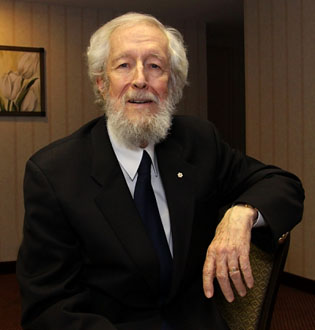Razutis, Al
Al Razutis, filmmaker, videographer, holographer (b at Bamberg, Germany 28 Apr 1946). Razutis moved to Vancouver from the US in 1968, following graduate studies in mathematical physics. His interest in the vivid imagery of popular media, his faith in the effects of strong sensations to induce ideological reform and his willingness to deal with political issues link him more closely to American filmmakers such as Robert Nelson, Bruce Conner and, closest in spirit to Razutis, Jerry Abrams, than to Vancouver film artists such as David Rimmer. A brilliant technician with sufficient knowledge of electronics to construct custom effects processors, Razutis was one of the first experimental filmmakers in Canada to use the optical and the video synthesizer (constructed with Jim Armstrong).
Razutis's major films are collected in 2 series: Amerika (1972-83), a study of the effects of "a media-excessive culture," and Visual Essays: Origins of Film (1973-82), which comprises a number of studies that attempt to reconstruct the vision of "cinematic creation occurring in the minds of cinema's primitives."
The differences between these 2 series indicate a tension between commitment to different types of modernism, the second more restrictive than the first. The first set grows out of a modernist engagement that allows for social comment and aims for social change. The second develops on those more stringent modernist beliefs that narrow the scope of investigation to the material of artistic medium and the forms appropriate to those materials.
In the mid-1980s, social comment assumed precedence and Razutis embarked on a series of performance pieces directed against the "establishment" in cinema studies in Canada. This culminated in a performance at the opening of Vancouver's Pacific Cine Centre in 1986 that included defacing the newly constructed facility. These events were documented in On the Autonomy of Art in Bourgeois Society, or Splice (1986), a film by Doug Chomyn, Scott Haynes and Al Razutis. In line with these oppositional efforts, Al Razutis also defied the Ontario Censor Board ruling demanding cuts in A Message From Our Sponsor (a film from the Amerika cycle), an action that brought down charges on Razutis and the exhibitors. Razutis became one of the principals in publishing the short-lived holography magazine, Wavefront (from 1985 to 1987) and the equally short-lived Opsis (1984), a journal devoted to commenting on the political ramifications of alternative cinema.
In 1987, Razutis resigned from his teaching position at Simon Fraser University and moved back to the Los Angeles area. In 1996 he returned to Canada's Gulf Islands and works principally in holography and virtual reality, and in media works for the World Wide Web, believing in the possibility of interactive motion-picture "projection systems."
See also Film, Experimental.

 Share on Facebook
Share on Facebook Share on X
Share on X Share by Email
Share by Email Share on Google Classroom
Share on Google Classroom


